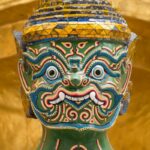When it comes to creating excitement for children about Japan, often folktales and myths are a great source of entertainment.
Not only can they bring about curiosity in Japan, but the myths also teach children about traditional Japanese culture.

If you require some help when it comes to Japanese tales that have stood the test of time, then look no further. Here you will find 8 of the most famous Japanese myths to tell your children.
Why Are Japanese Myths Important?
Japanese myths and folktales are very important because they can teach people about traditional Japanese culture. However, a lot of them are dark and not suitable for children.
Even so, there are many child-friendly versions of these myths and folktales, meaning children can learn about Japan’s folklore in an exciting way. Often some books and stories depict these myths.
The myths include strange creatures and odd stories that can provide a wonderful imagination of old-time Japan for your children.
8 Most Famous Japanese Myths
Here are 8 of the most famous and well-known Japanese myths to tell your children:
1. Urashima Taro
Firstly we shall start with the Urashima Taro tale. This story is all about teaching people about obedience, and how it can be much more important than being happy. This is a great one to tell your children.
Fisherman Urashima Taro is the central character in this story. He rescues a struggling turtle. Because of this, he gets a reward. The reward is a chance to visit a kingdom based under the ocean where the Dragon God lives.
Here he speaks to the princess. She passes him a box and says that if he keeps it closed, and never opens it, he will be happy for the rest of his life.
Once he returns to his home he opens the box. Because of this, he ends up being punished due to disobedience.
2. Kintaro
A really popular tale for children is Kintaro. Also referred to as the Golden Boy, many people in Japan know this story by heart.
You will find that there are several versions of the Kintaro story, however, they all have a similar theme and plot. This is because it is about a boy named Kintaro who has very strong and impressive powers.
He also has been brought up living in a forest, meaning he has many friends who are animals. This is similar to Tarzan. However, the story is said to have been influenced by parents who wanted to have a boy who grows up to be full of courage and strength.
Kintaro has been referenced in many well-known pop culture outlets, such as the manga and anime One Piece, as well as Otogo Zoshi.
3. Bunbuku Chagama
Bunbuku Chagama translates to ‘happiness bubbling over like a teapot’. This story involves a tanuki that an old man decides to rescue when he sees it is trapped.
Tanuki is a Japanese raccoon dog. This breed of animal has been referred to in many Japanese folklore tales due to many saying it has shape-shifting abilities.
Because the older man rescues the tanuki, he is rewarded by the wild canine. The tanuki transforms itself into a tea kettle (chagama) and orders the man to sell his shape-shifted form to receive money.
So the man sells the ‘tea kettle’ to an oblivious monk. The monk scrubs and cleans the tea kettle, and then puts it over the fire to boil water inside.
However, the tanuki does not want to be burned alive, nor does he like the heat of the fire. Because of this, the tea kettle grows both legs and arms and runs away.
4. Momataro
The most famous folktale of Japan is Momotaro. The word ‘Momotaro’ translates to ‘Peach Taro’, which is a suffix heard plenty throughout Japan.
Another name for this folktale is Peach Boy. This is because it is said that Momotaro visited Earth using a giant peach. This was set in the present day when Tokyo was known as Edo.
The giant peach was first encountered by a husband and wife who saw it floating upon a river. They were washing clothes and decided to take the peach home to eat. However, they found a boy inside the peach.
The boy explained that he had come from Heaven and was now to be their son. When the boy was older, he fought ogres and demons. Along his travels, he met a dog, a monkey, and a pheasant – all of whom could talk.
He returned home after finding treasure and defeating lots of enemies. He never had to go and fight again, as he and his family lived a very happy and peaceful life.
5. Shita-Kiri Suzume
If you want to teach your children about the consequences when it comes to both jealousy and greed, then this Shita-Kiri Suzume tale is a good place to start. Not only is it very famous in Japan, but it is full of morals too.
The word Shita-Kiri-Suzume also means ‘tongue-cut sparrow’. This myth can also be called ‘The Sparrow with the Split/Slit Tongue’.
The story is based on kindness, jealousy, and greed. To cut a long story short, the main characters are given different rewards depending on their own actions.
For example, the woman is given snakes only due to her unfavorable actions. Meanwhile, the man is rewarded with a wonderful evening with the human who was once a sparrow. He also gets to keep a big chest of gold, too.
6. Issun-Boshi
This story is about a boy who is only 1 inch tall. For this reason, the story is often referred to as ‘One Inch Boy’, or ‘Little One Inch’.
It is a tale that has been changed here and there, meaning it has many different twists and turns depending on where you hear the story. Despite this, the main tale is the same no matter where you hear it.
The story is about an old couple who do not have children. The woman begins to wish for a child, and says: “Please, please let us have a child, no matter how small”.
They eventually have a child, and it is small. In fact, so small, it is tinier than the tip of a finger.
The boy is named Issun-Boshi, with the latter word translating to ‘son’. Over time he realizes that he will never grow in size. Despite this, he ends up becoming a mini samurai. He even uses a sewing needle as his weapon.
When he ventures across the water, chopsticks are used as oars and a soup bowl is used for the boat. This makes for a wonderfully interesting story.
7. Kachi-Kachi Yama
The name of this story is in reference to the sound of crackling wood. The word ‘yama’ translates to ‘mountain’. While this story is fine to tell children, it is on the darker side than the others in this list.
This is because violence is used by the tanuki. However, he is then punished for these actions by the rabbit later on in the story. It can offer valuable lessons to children, but you may want to tell this story to those over the age of 12 only.
The story involves a man who finds a tanuki who is causing trouble within the field at his home. He ends up tying the tanuki to a tree ready to cook and eat it at a later date.
He leaves home temporarily to visit the local town. While he is away, the tanuki begs and cries for the wife of the man to let him go free. While making mochi (a delicious sweet and glutinous rice cake), she gives in and lets him go.
However, the tanuki decides to kill her after his horrible trick. Later on in the story, the tanuki is punished for his actions.
8. Kaguyahime
Kaguyahime is often referenced as The Tale of the Bamboo Cutter. It is a very popular Japanese tale that depicts a girl who is found within a bamboo plant.
This bamboo plant glows as the baby girl known as Kaguya-hime is nestled within the stalk. The growing plant is healthy and mysterious.
This story has been adapted within popular culture many times. The most famous adaptation was done by Studio Ghibli for the film The Tale of the Princess Kaguya. It was the company’s 20th film ever made back in 2013.
Final Thoughts
There are many Japanese myths and folktales to tell your children. From a boy who travels down a river in a peach, to the tanuki who turns into a tea kettle – you will be spoilt for choice!
Generally, Japanese myths and folktales can be dark.
For this reason, you may want to handpick the kind of stories you tell to children. However, there are plenty of stories that are suitable for young children too, including Momataro and Kintaro.
- 16 Best Websites To Watch Japanese Movies With English Subtitles - May 11, 2023
- Is ZIPAIR The Best Airline For Traveling To Japan? - May 11, 2023
- Ryu Murakami Vs Haruki Murakami – Which One Should You Read? - May 11, 2023








